International Finance Strategies: A Case Study of Thomas Cook Group
VerifiedAdded on 2023/04/08
|9
|2098
|442
Report
AI Summary
This report provides an analysis of international finance strategies employed by Thomas Cook Group, focusing on the management of transaction exposure, exchange rate exposure, and economic exposure. It reviews relevant literature on these aspects, highlighting the risks associated with international financial transactions and the importance of hedging strategies. The report examines how Thomas Cook utilizes currency forwards, swaps, and options to mitigate transaction exposure and manages exchange rate exposure through hedging policies and financial instruments. Furthermore, it discusses the company's approach to managing economic exposure through currency hedges and cross-currency interest rate swaps. The analysis draws from Thomas Cook's 2018 Annual Report to illustrate these strategies in practice, emphasizing the company's proactive measures to address the challenges posed by fluctuating exchange rates and macroeconomic conditions. The report concludes by noting the importance of these strategies for Thomas Cook's future success in the travel and tourism industry.
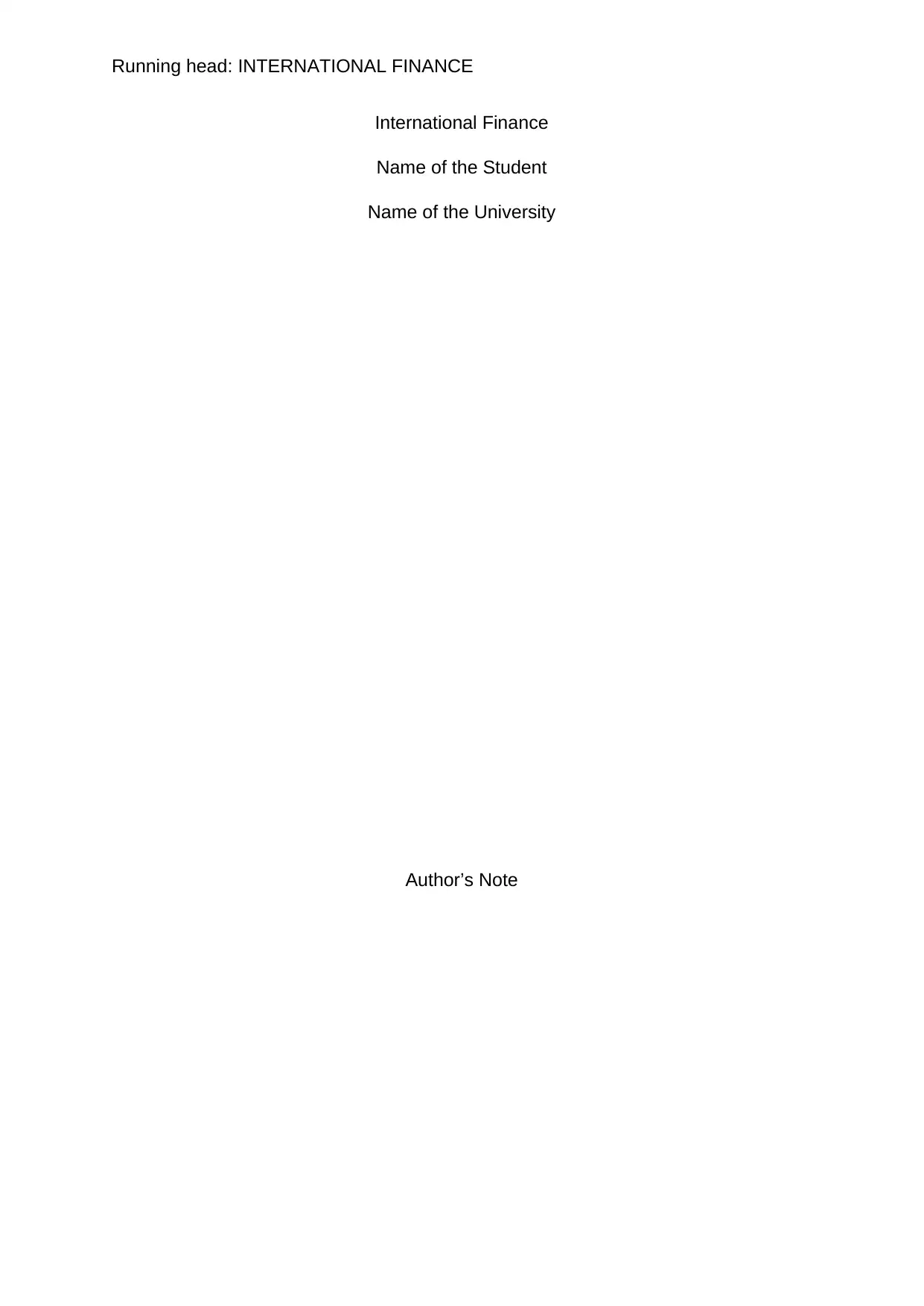
Running head: INTERNATIONAL FINANCE
International Finance
Name of the Student
Name of the University
Author’s Note
International Finance
Name of the Student
Name of the University
Author’s Note
Paraphrase This Document
Need a fresh take? Get an instant paraphrase of this document with our AI Paraphraser
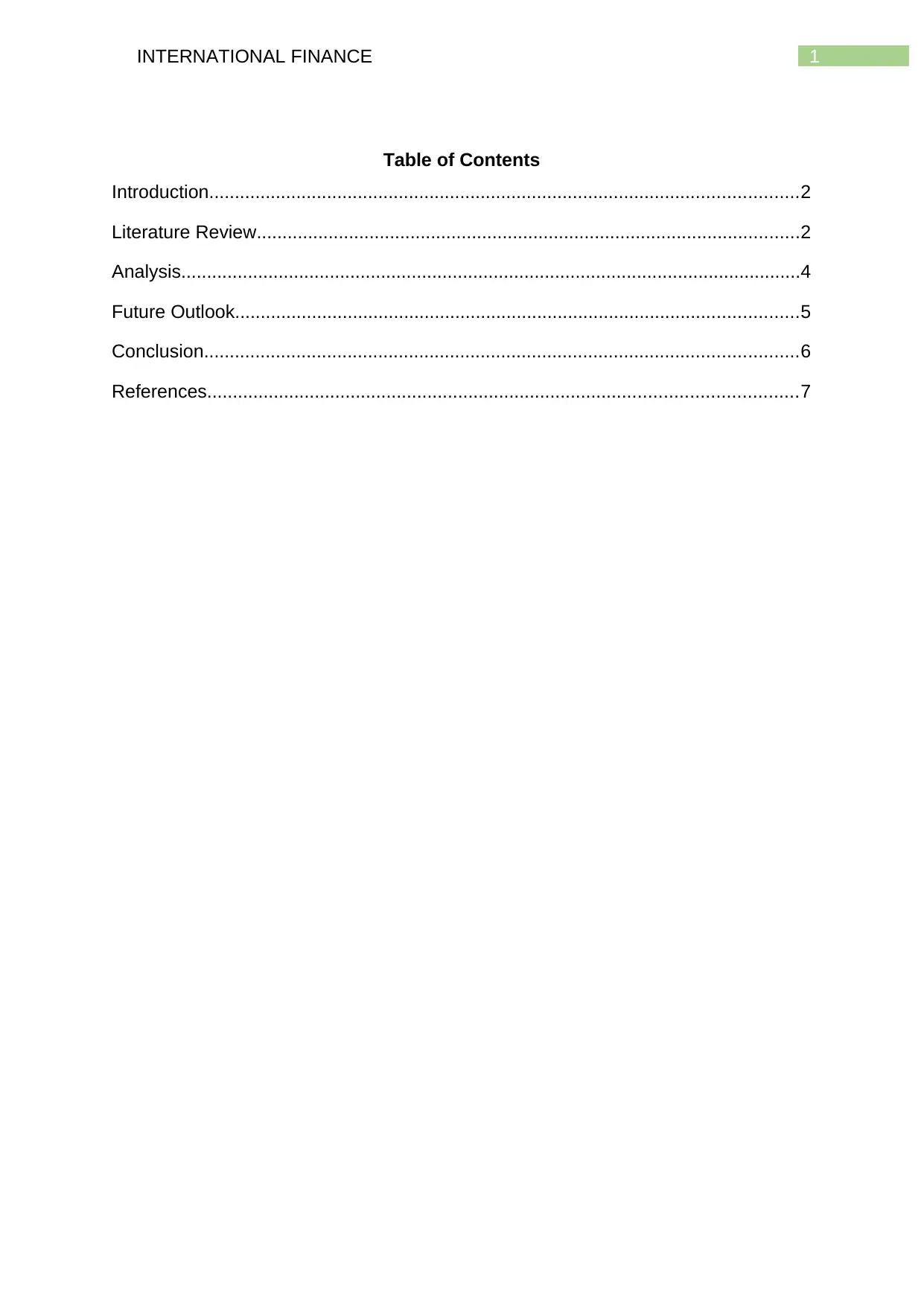
1INTERNATIONAL FINANCE
Table of Contents
Introduction...................................................................................................................2
Literature Review..........................................................................................................2
Analysis.........................................................................................................................4
Future Outlook..............................................................................................................5
Conclusion....................................................................................................................6
References...................................................................................................................7
Table of Contents
Introduction...................................................................................................................2
Literature Review..........................................................................................................2
Analysis.........................................................................................................................4
Future Outlook..............................................................................................................5
Conclusion....................................................................................................................6
References...................................................................................................................7

2INTERNATIONAL FINANCE
Introduction
International Finance is considered as an important aspect for the companies
to ensure long-term business success. International finance involves in the monetary
transactions that take place between two of more countries (Avdjiev, McCauley and
Shin 2016). Financial transactions across borders create different challenges and
issues related to currency exchange rates and the exploration of developing
economics. For this reason, international finance is considered as a technique of
analysing economic status of the countries in which another country wish to expand
as it helps in judging the foreign market, comparing inflation rates and paying bills in
the rate of foreign currency (Cairncross 2016). It is not possible for the companies to
compare currency exchange rates in the absence of international finance. The main
aim of this report is to analyse and evaluate different aspects of international finance
of Thomas Cook; such as management of transaction exposure, mechanism of
managing exchange rate exposure and management of economic exposure.
Literature Review
There are many aspects that the companies are needed to take into
consideration while dealing with international finance. This part of the report focuses
on thee aspects of international finance; they are transaction exposure, internal as
well as external mechanism of exchange rate exposure and the process to manage
economic exposure while considering the macroeconomic exposure.
Transaction Exposure Management – Transaction exposer is referred to the level
of risk the companies have to face in international business. More specifically,
transaction exposure is considered as the risk of loss due to the change in exchange
rates while conducting international trade (Hutson and Laing 2014). The derivation of
this exposure can be seen from change in the rate of foreign exchange between the
date of the transaction and the date of transaction settlement. For example, a
company in United Kingdom (UK) may sell goods to another company in United
States (US) and the value is £100,000, but later, when the customer makes the
payment to the company, the payment made for £95,000 due to the change in
exchange rate. As per the above example, the seller has to incur a loss of £5,000
due to the change in the exchange rate. The application of transaction exposure can
be seen only to the party in the transaction that needs to make payment or receive
Introduction
International Finance is considered as an important aspect for the companies
to ensure long-term business success. International finance involves in the monetary
transactions that take place between two of more countries (Avdjiev, McCauley and
Shin 2016). Financial transactions across borders create different challenges and
issues related to currency exchange rates and the exploration of developing
economics. For this reason, international finance is considered as a technique of
analysing economic status of the countries in which another country wish to expand
as it helps in judging the foreign market, comparing inflation rates and paying bills in
the rate of foreign currency (Cairncross 2016). It is not possible for the companies to
compare currency exchange rates in the absence of international finance. The main
aim of this report is to analyse and evaluate different aspects of international finance
of Thomas Cook; such as management of transaction exposure, mechanism of
managing exchange rate exposure and management of economic exposure.
Literature Review
There are many aspects that the companies are needed to take into
consideration while dealing with international finance. This part of the report focuses
on thee aspects of international finance; they are transaction exposure, internal as
well as external mechanism of exchange rate exposure and the process to manage
economic exposure while considering the macroeconomic exposure.
Transaction Exposure Management – Transaction exposer is referred to the level
of risk the companies have to face in international business. More specifically,
transaction exposure is considered as the risk of loss due to the change in exchange
rates while conducting international trade (Hutson and Laing 2014). The derivation of
this exposure can be seen from change in the rate of foreign exchange between the
date of the transaction and the date of transaction settlement. For example, a
company in United Kingdom (UK) may sell goods to another company in United
States (US) and the value is £100,000, but later, when the customer makes the
payment to the company, the payment made for £95,000 due to the change in
exchange rate. As per the above example, the seller has to incur a loss of £5,000
due to the change in the exchange rate. The application of transaction exposure can
be seen only to the party in the transaction that needs to make payment or receive
⊘ This is a preview!⊘
Do you want full access?
Subscribe today to unlock all pages.

Trusted by 1+ million students worldwide
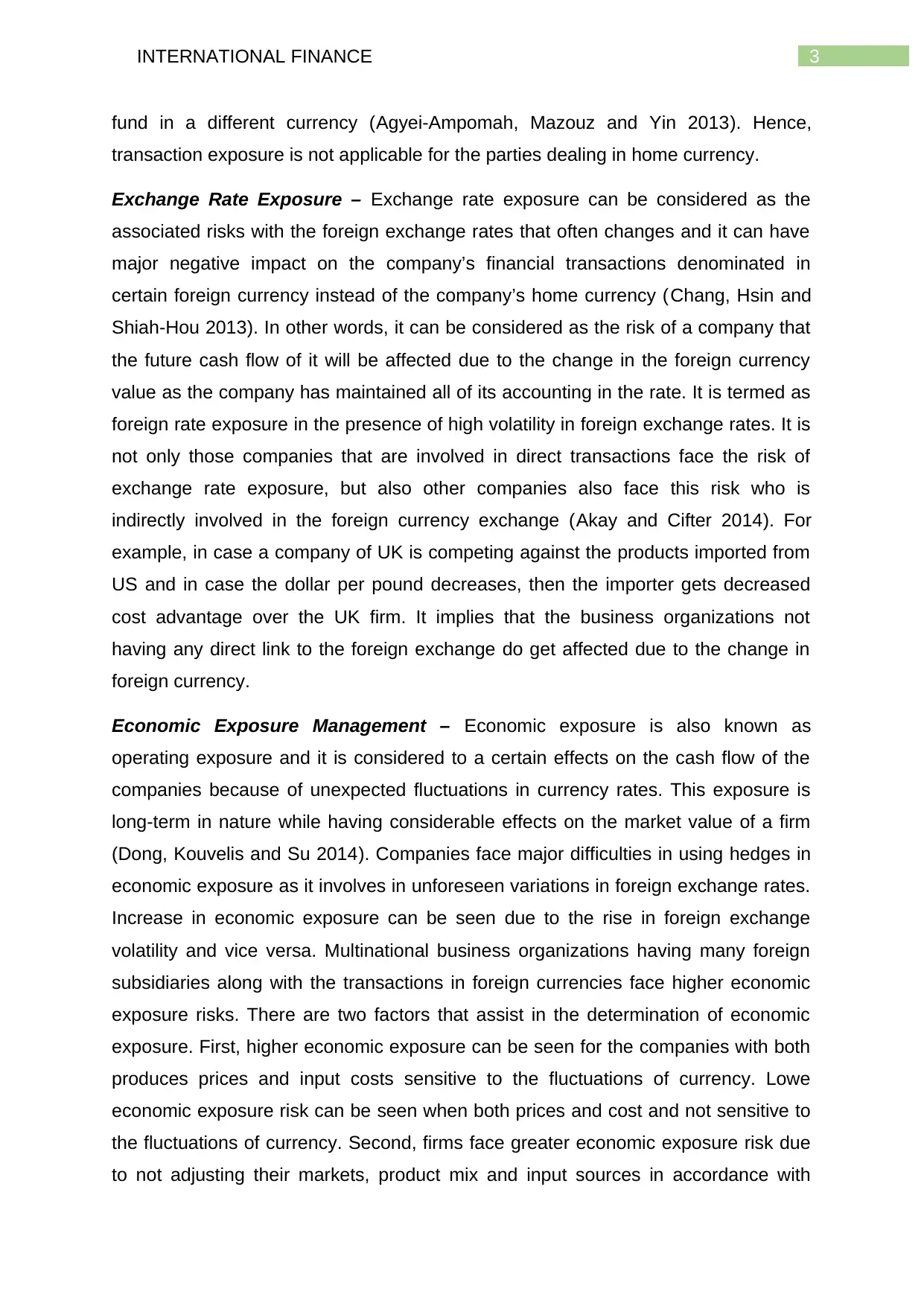
3INTERNATIONAL FINANCE
fund in a different currency (Agyei-Ampomah, Mazouz and Yin 2013). Hence,
transaction exposure is not applicable for the parties dealing in home currency.
Exchange Rate Exposure – Exchange rate exposure can be considered as the
associated risks with the foreign exchange rates that often changes and it can have
major negative impact on the company’s financial transactions denominated in
certain foreign currency instead of the company’s home currency (Chang, Hsin and
Shiah-Hou 2013). In other words, it can be considered as the risk of a company that
the future cash flow of it will be affected due to the change in the foreign currency
value as the company has maintained all of its accounting in the rate. It is termed as
foreign rate exposure in the presence of high volatility in foreign exchange rates. It is
not only those companies that are involved in direct transactions face the risk of
exchange rate exposure, but also other companies also face this risk who is
indirectly involved in the foreign currency exchange (Akay and Cifter 2014). For
example, in case a company of UK is competing against the products imported from
US and in case the dollar per pound decreases, then the importer gets decreased
cost advantage over the UK firm. It implies that the business organizations not
having any direct link to the foreign exchange do get affected due to the change in
foreign currency.
Economic Exposure Management – Economic exposure is also known as
operating exposure and it is considered to a certain effects on the cash flow of the
companies because of unexpected fluctuations in currency rates. This exposure is
long-term in nature while having considerable effects on the market value of a firm
(Dong, Kouvelis and Su 2014). Companies face major difficulties in using hedges in
economic exposure as it involves in unforeseen variations in foreign exchange rates.
Increase in economic exposure can be seen due to the rise in foreign exchange
volatility and vice versa. Multinational business organizations having many foreign
subsidiaries along with the transactions in foreign currencies face higher economic
exposure risks. There are two factors that assist in the determination of economic
exposure. First, higher economic exposure can be seen for the companies with both
produces prices and input costs sensitive to the fluctuations of currency. Lowe
economic exposure risk can be seen when both prices and cost and not sensitive to
the fluctuations of currency. Second, firms face greater economic exposure risk due
to not adjusting their markets, product mix and input sources in accordance with
fund in a different currency (Agyei-Ampomah, Mazouz and Yin 2013). Hence,
transaction exposure is not applicable for the parties dealing in home currency.
Exchange Rate Exposure – Exchange rate exposure can be considered as the
associated risks with the foreign exchange rates that often changes and it can have
major negative impact on the company’s financial transactions denominated in
certain foreign currency instead of the company’s home currency (Chang, Hsin and
Shiah-Hou 2013). In other words, it can be considered as the risk of a company that
the future cash flow of it will be affected due to the change in the foreign currency
value as the company has maintained all of its accounting in the rate. It is termed as
foreign rate exposure in the presence of high volatility in foreign exchange rates. It is
not only those companies that are involved in direct transactions face the risk of
exchange rate exposure, but also other companies also face this risk who is
indirectly involved in the foreign currency exchange (Akay and Cifter 2014). For
example, in case a company of UK is competing against the products imported from
US and in case the dollar per pound decreases, then the importer gets decreased
cost advantage over the UK firm. It implies that the business organizations not
having any direct link to the foreign exchange do get affected due to the change in
foreign currency.
Economic Exposure Management – Economic exposure is also known as
operating exposure and it is considered to a certain effects on the cash flow of the
companies because of unexpected fluctuations in currency rates. This exposure is
long-term in nature while having considerable effects on the market value of a firm
(Dong, Kouvelis and Su 2014). Companies face major difficulties in using hedges in
economic exposure as it involves in unforeseen variations in foreign exchange rates.
Increase in economic exposure can be seen due to the rise in foreign exchange
volatility and vice versa. Multinational business organizations having many foreign
subsidiaries along with the transactions in foreign currencies face higher economic
exposure risks. There are two factors that assist in the determination of economic
exposure. First, higher economic exposure can be seen for the companies with both
produces prices and input costs sensitive to the fluctuations of currency. Lowe
economic exposure risk can be seen when both prices and cost and not sensitive to
the fluctuations of currency. Second, firms face greater economic exposure risk due
to not adjusting their markets, product mix and input sources in accordance with
Paraphrase This Document
Need a fresh take? Get an instant paraphrase of this document with our AI Paraphraser

4INTERNATIONAL FINANCE
currency fluctuations (Kawaller 2015). Companies having flexibility in adapting
currency rate fluctuations face lower risk of economic exposure.
Analysis
It can be seen from the 2018 Annual Report of Thomas Cook that the
company has adopted certain international finance strategies with the aim to manage
as well as mitigate the above-discussed risks and they are discussed below:
Transaction Exposure Management – It needs to be mentioned that Thomas Cook
is a British travel company and the company has to involve in cross borders financial
transactions due to the nature of the industry. As per the 2018 Annual Report of
Thomas Cook, the company uses currency forwards, currency swaps and currency
options for managing their transaction exposure risk; and these options are
considered as Cash Flow Hedges (thomascookgroup.com 2019). The 2018 Annual
Report of Thomas Cook also states that use of these cash flow hedges can be seen
by the company for managing the transaction exposure risk related to fuel price. The
fuel hedges in place drive the assumptions of fuel price along with the forward fuel
curve at the time of setting budgets (Arcelus, Gor and Srinivasan 2013). The hedge
in related items of the company are subject to market fluctuations and they are
undone in the maturity of the forward contracts. At the same time, Thomas Cook
enters into fixed price contract swaps along with the net purchase options with the
aim to manage transaction exposure in the fuel price. At the same time, Thomas
Cook enters into interest rate swaps for hedging the interest rates along with the
currency exposure on foreign currency external borrowings (Michaelson and
Mulholland 2014).
Exchange Rate Exposure – It needs to be mentioned that Thomas Cook is
exposed to exchange rate risk or exchange rate exposure due their foreign business
operations and transactions. Since the company has business activities in large
number of countries, its business operations are exposed to fluctuations in exchange
rate (Bacha et al. 2013). The occurrence of this risk can be seen in related to service
procurement in destination outside the source market. It is needed for the company
to identify all segments and appropriately hedge all exchange rate exposures by
complying with the required treasury policies. Every segment hedging policy includes
the hedging build up along with the permitted financial instruments. In this aspect,
currency fluctuations (Kawaller 2015). Companies having flexibility in adapting
currency rate fluctuations face lower risk of economic exposure.
Analysis
It can be seen from the 2018 Annual Report of Thomas Cook that the
company has adopted certain international finance strategies with the aim to manage
as well as mitigate the above-discussed risks and they are discussed below:
Transaction Exposure Management – It needs to be mentioned that Thomas Cook
is a British travel company and the company has to involve in cross borders financial
transactions due to the nature of the industry. As per the 2018 Annual Report of
Thomas Cook, the company uses currency forwards, currency swaps and currency
options for managing their transaction exposure risk; and these options are
considered as Cash Flow Hedges (thomascookgroup.com 2019). The 2018 Annual
Report of Thomas Cook also states that use of these cash flow hedges can be seen
by the company for managing the transaction exposure risk related to fuel price. The
fuel hedges in place drive the assumptions of fuel price along with the forward fuel
curve at the time of setting budgets (Arcelus, Gor and Srinivasan 2013). The hedge
in related items of the company are subject to market fluctuations and they are
undone in the maturity of the forward contracts. At the same time, Thomas Cook
enters into fixed price contract swaps along with the net purchase options with the
aim to manage transaction exposure in the fuel price. At the same time, Thomas
Cook enters into interest rate swaps for hedging the interest rates along with the
currency exposure on foreign currency external borrowings (Michaelson and
Mulholland 2014).
Exchange Rate Exposure – It needs to be mentioned that Thomas Cook is
exposed to exchange rate risk or exchange rate exposure due their foreign business
operations and transactions. Since the company has business activities in large
number of countries, its business operations are exposed to fluctuations in exchange
rate (Bacha et al. 2013). The occurrence of this risk can be seen in related to service
procurement in destination outside the source market. It is needed for the company
to identify all segments and appropriately hedge all exchange rate exposures by
complying with the required treasury policies. Every segment hedging policy includes
the hedging build up along with the permitted financial instruments. In this aspect,

5INTERNATIONAL FINANCE
the maximum tenor for hedge is 24 months and it is needed for every segment to
achieve at least an 80% hedge ratio before the commencement of the season
(thomascookgroup.com 2019). In this aspect also, the company utilizes the aspects
like forward currency, currency swaps and currency options for managing this
exchange rate exposure risk. In this context, it needs to be mentioned that Thomas
Cook does not become involved in the hedging of translation exposure that arises
from generated profit outside the UK (Tang 2015).
Economic Exposure Management – It can be seen from the above discussion that
Thomas Cook has to face risks related to economic exposure due to the industry as
well as macroeconomic environment. It can be seen from the 2018 Annual Report of
Thomas Cook that the company uses currency hedges for managing the economic
exposure. More specifically, the company enters into currency hedges up to a
maximum of 24 months in advance of the forecasted requirements (Bali, Brown and
Caglayan 2014). At the same time, it can also be seen from the 2018 Annual Report
of Thomas Cook that the company also enters into cross currency interest rate swap
for hedging the interest rate and the currency hedge relationships
(thomascookgroup.com 2019). It can also be seen from the annual report of the
company that the financial instruments of the company are exposed to movement in
foreign currency exchange rates. The adopted strategies help the company in
managing all these risks related to economic exposure (Ye, Hutson and Muckley
2014).
Future Outlook
It can be seen from the above that Thomas Cook operates in the travel and
tourism industry and forecast states that this particular industry will continue
outpacing the global GDP growth, at 3.8% per annual versus 3.7% respectively. In
addition, within this particular sector, there is a forecast of growth in the package
travel to 9% in volume to the year 2022. For this reason, Thomas Cook has entered
into fuel price hedges up to maximum of 24 months in advance of forecasted fuel
consumption. The company has also entered into currency hedges on the same
basis as fuel price hedge (thomascookgroup.com 2019).
the maximum tenor for hedge is 24 months and it is needed for every segment to
achieve at least an 80% hedge ratio before the commencement of the season
(thomascookgroup.com 2019). In this aspect also, the company utilizes the aspects
like forward currency, currency swaps and currency options for managing this
exchange rate exposure risk. In this context, it needs to be mentioned that Thomas
Cook does not become involved in the hedging of translation exposure that arises
from generated profit outside the UK (Tang 2015).
Economic Exposure Management – It can be seen from the above discussion that
Thomas Cook has to face risks related to economic exposure due to the industry as
well as macroeconomic environment. It can be seen from the 2018 Annual Report of
Thomas Cook that the company uses currency hedges for managing the economic
exposure. More specifically, the company enters into currency hedges up to a
maximum of 24 months in advance of the forecasted requirements (Bali, Brown and
Caglayan 2014). At the same time, it can also be seen from the 2018 Annual Report
of Thomas Cook that the company also enters into cross currency interest rate swap
for hedging the interest rate and the currency hedge relationships
(thomascookgroup.com 2019). It can also be seen from the annual report of the
company that the financial instruments of the company are exposed to movement in
foreign currency exchange rates. The adopted strategies help the company in
managing all these risks related to economic exposure (Ye, Hutson and Muckley
2014).
Future Outlook
It can be seen from the above that Thomas Cook operates in the travel and
tourism industry and forecast states that this particular industry will continue
outpacing the global GDP growth, at 3.8% per annual versus 3.7% respectively. In
addition, within this particular sector, there is a forecast of growth in the package
travel to 9% in volume to the year 2022. For this reason, Thomas Cook has entered
into fuel price hedges up to maximum of 24 months in advance of forecasted fuel
consumption. The company has also entered into currency hedges on the same
basis as fuel price hedge (thomascookgroup.com 2019).
⊘ This is a preview!⊘
Do you want full access?
Subscribe today to unlock all pages.

Trusted by 1+ million students worldwide
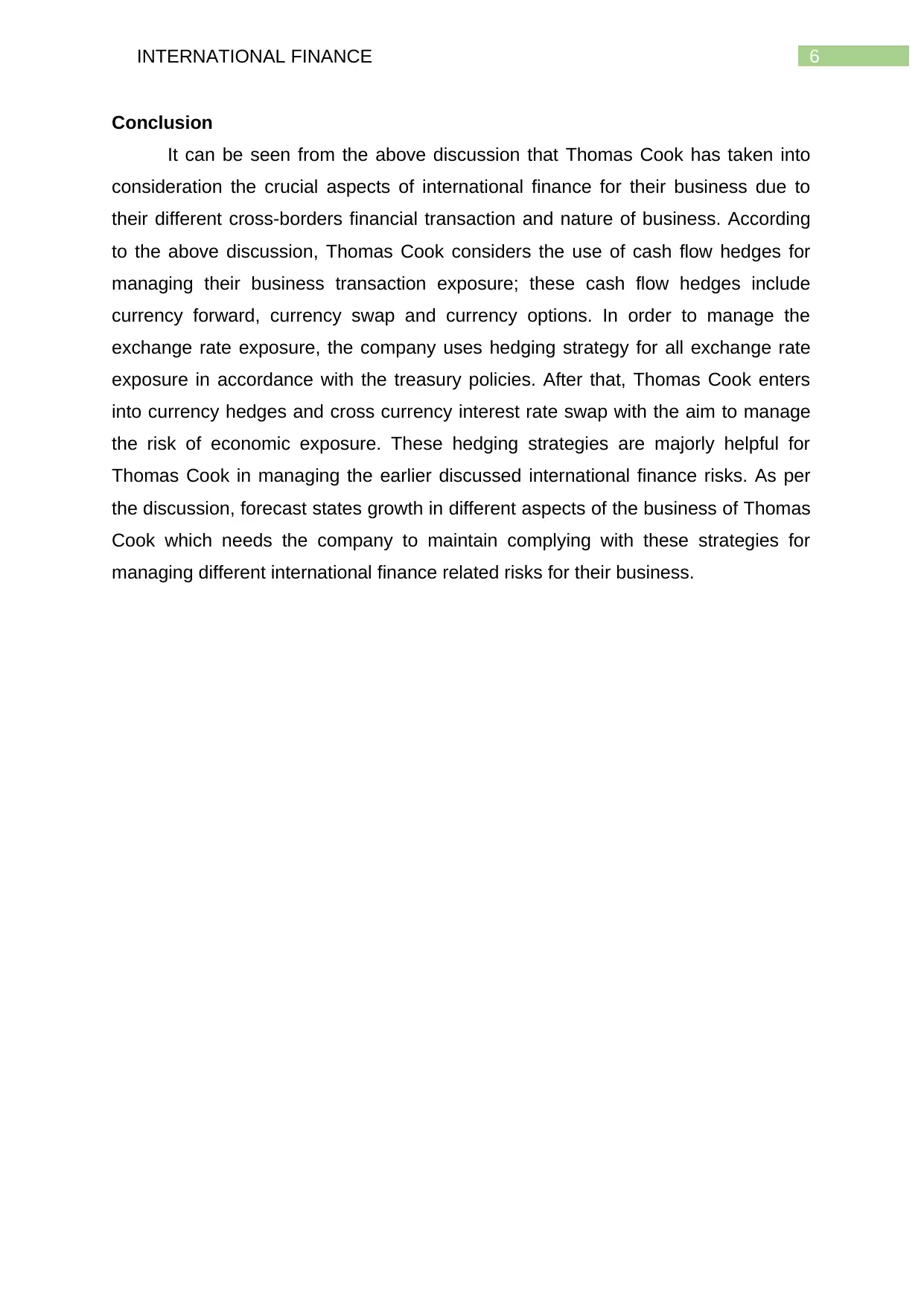
6INTERNATIONAL FINANCE
Conclusion
It can be seen from the above discussion that Thomas Cook has taken into
consideration the crucial aspects of international finance for their business due to
their different cross-borders financial transaction and nature of business. According
to the above discussion, Thomas Cook considers the use of cash flow hedges for
managing their business transaction exposure; these cash flow hedges include
currency forward, currency swap and currency options. In order to manage the
exchange rate exposure, the company uses hedging strategy for all exchange rate
exposure in accordance with the treasury policies. After that, Thomas Cook enters
into currency hedges and cross currency interest rate swap with the aim to manage
the risk of economic exposure. These hedging strategies are majorly helpful for
Thomas Cook in managing the earlier discussed international finance risks. As per
the discussion, forecast states growth in different aspects of the business of Thomas
Cook which needs the company to maintain complying with these strategies for
managing different international finance related risks for their business.
Conclusion
It can be seen from the above discussion that Thomas Cook has taken into
consideration the crucial aspects of international finance for their business due to
their different cross-borders financial transaction and nature of business. According
to the above discussion, Thomas Cook considers the use of cash flow hedges for
managing their business transaction exposure; these cash flow hedges include
currency forward, currency swap and currency options. In order to manage the
exchange rate exposure, the company uses hedging strategy for all exchange rate
exposure in accordance with the treasury policies. After that, Thomas Cook enters
into currency hedges and cross currency interest rate swap with the aim to manage
the risk of economic exposure. These hedging strategies are majorly helpful for
Thomas Cook in managing the earlier discussed international finance risks. As per
the discussion, forecast states growth in different aspects of the business of Thomas
Cook which needs the company to maintain complying with these strategies for
managing different international finance related risks for their business.
Paraphrase This Document
Need a fresh take? Get an instant paraphrase of this document with our AI Paraphraser
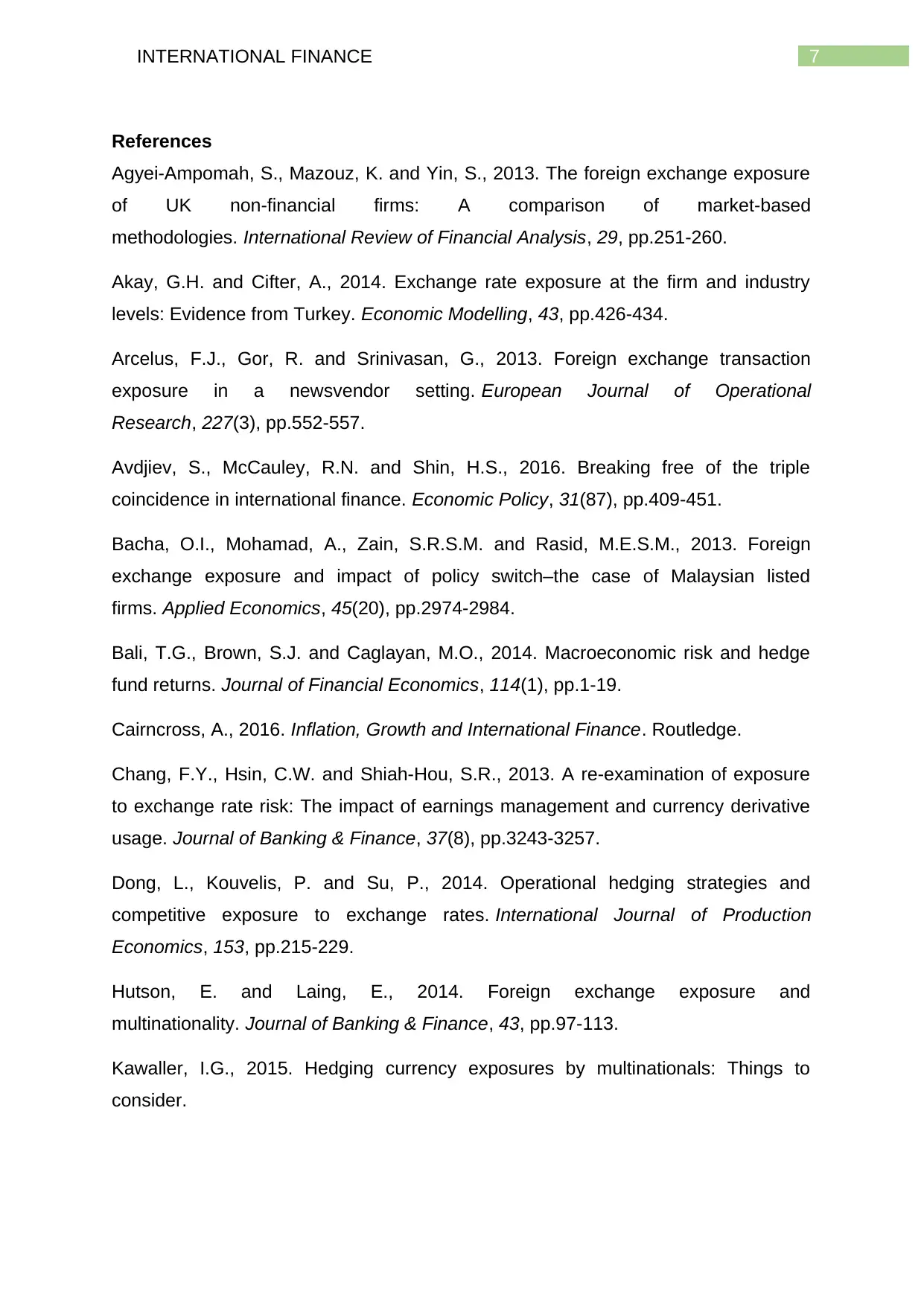
7INTERNATIONAL FINANCE
References
Agyei-Ampomah, S., Mazouz, K. and Yin, S., 2013. The foreign exchange exposure
of UK non-financial firms: A comparison of market-based
methodologies. International Review of Financial Analysis, 29, pp.251-260.
Akay, G.H. and Cifter, A., 2014. Exchange rate exposure at the firm and industry
levels: Evidence from Turkey. Economic Modelling, 43, pp.426-434.
Arcelus, F.J., Gor, R. and Srinivasan, G., 2013. Foreign exchange transaction
exposure in a newsvendor setting. European Journal of Operational
Research, 227(3), pp.552-557.
Avdjiev, S., McCauley, R.N. and Shin, H.S., 2016. Breaking free of the triple
coincidence in international finance. Economic Policy, 31(87), pp.409-451.
Bacha, O.I., Mohamad, A., Zain, S.R.S.M. and Rasid, M.E.S.M., 2013. Foreign
exchange exposure and impact of policy switch–the case of Malaysian listed
firms. Applied Economics, 45(20), pp.2974-2984.
Bali, T.G., Brown, S.J. and Caglayan, M.O., 2014. Macroeconomic risk and hedge
fund returns. Journal of Financial Economics, 114(1), pp.1-19.
Cairncross, A., 2016. Inflation, Growth and International Finance. Routledge.
Chang, F.Y., Hsin, C.W. and Shiah-Hou, S.R., 2013. A re-examination of exposure
to exchange rate risk: The impact of earnings management and currency derivative
usage. Journal of Banking & Finance, 37(8), pp.3243-3257.
Dong, L., Kouvelis, P. and Su, P., 2014. Operational hedging strategies and
competitive exposure to exchange rates. International Journal of Production
Economics, 153, pp.215-229.
Hutson, E. and Laing, E., 2014. Foreign exchange exposure and
multinationality. Journal of Banking & Finance, 43, pp.97-113.
Kawaller, I.G., 2015. Hedging currency exposures by multinationals: Things to
consider.
References
Agyei-Ampomah, S., Mazouz, K. and Yin, S., 2013. The foreign exchange exposure
of UK non-financial firms: A comparison of market-based
methodologies. International Review of Financial Analysis, 29, pp.251-260.
Akay, G.H. and Cifter, A., 2014. Exchange rate exposure at the firm and industry
levels: Evidence from Turkey. Economic Modelling, 43, pp.426-434.
Arcelus, F.J., Gor, R. and Srinivasan, G., 2013. Foreign exchange transaction
exposure in a newsvendor setting. European Journal of Operational
Research, 227(3), pp.552-557.
Avdjiev, S., McCauley, R.N. and Shin, H.S., 2016. Breaking free of the triple
coincidence in international finance. Economic Policy, 31(87), pp.409-451.
Bacha, O.I., Mohamad, A., Zain, S.R.S.M. and Rasid, M.E.S.M., 2013. Foreign
exchange exposure and impact of policy switch–the case of Malaysian listed
firms. Applied Economics, 45(20), pp.2974-2984.
Bali, T.G., Brown, S.J. and Caglayan, M.O., 2014. Macroeconomic risk and hedge
fund returns. Journal of Financial Economics, 114(1), pp.1-19.
Cairncross, A., 2016. Inflation, Growth and International Finance. Routledge.
Chang, F.Y., Hsin, C.W. and Shiah-Hou, S.R., 2013. A re-examination of exposure
to exchange rate risk: The impact of earnings management and currency derivative
usage. Journal of Banking & Finance, 37(8), pp.3243-3257.
Dong, L., Kouvelis, P. and Su, P., 2014. Operational hedging strategies and
competitive exposure to exchange rates. International Journal of Production
Economics, 153, pp.215-229.
Hutson, E. and Laing, E., 2014. Foreign exchange exposure and
multinationality. Journal of Banking & Finance, 43, pp.97-113.
Kawaller, I.G., 2015. Hedging currency exposures by multinationals: Things to
consider.
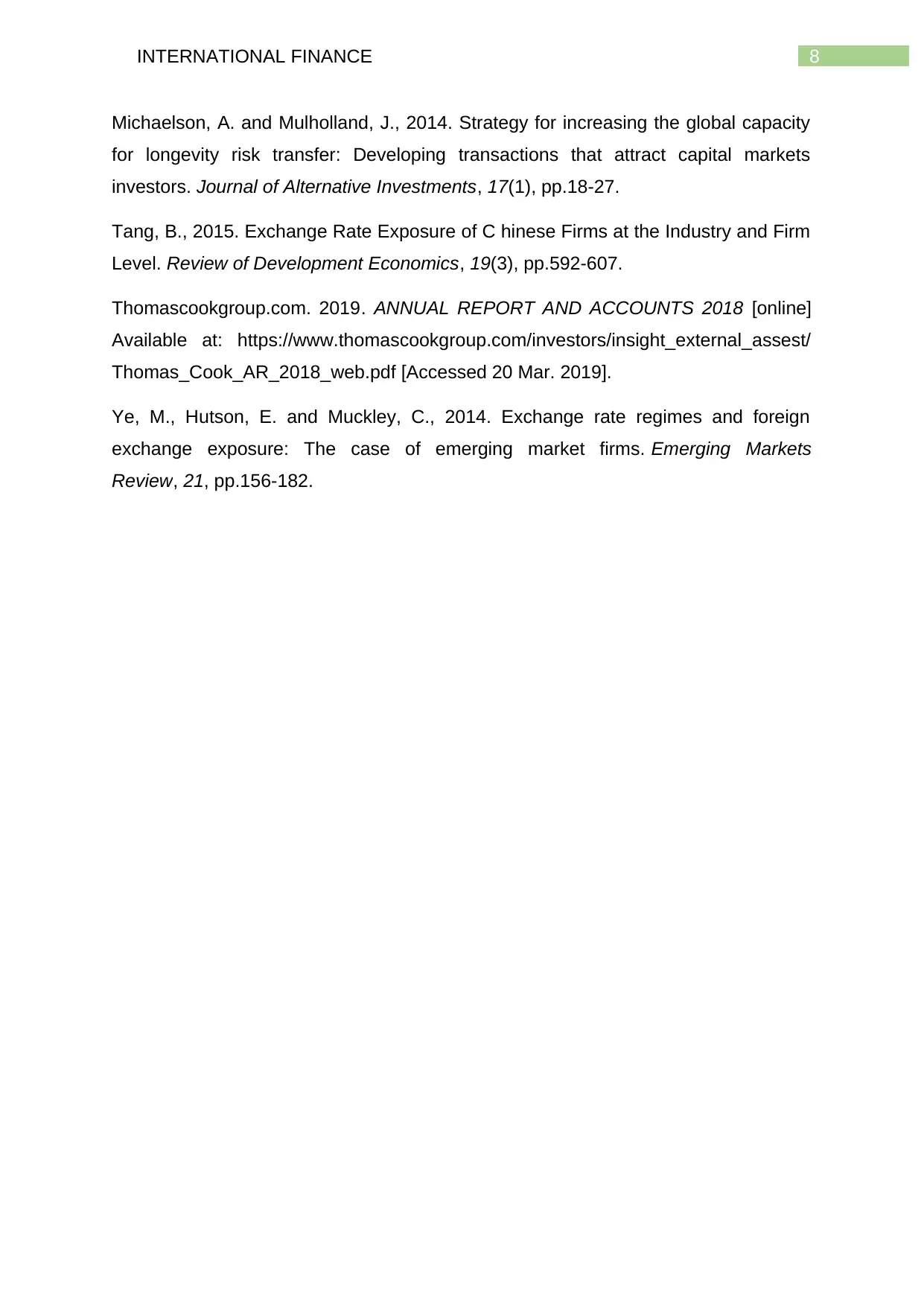
8INTERNATIONAL FINANCE
Michaelson, A. and Mulholland, J., 2014. Strategy for increasing the global capacity
for longevity risk transfer: Developing transactions that attract capital markets
investors. Journal of Alternative Investments, 17(1), pp.18-27.
Tang, B., 2015. Exchange Rate Exposure of C hinese Firms at the Industry and Firm
Level. Review of Development Economics, 19(3), pp.592-607.
Thomascookgroup.com. 2019. ANNUAL REPORT AND ACCOUNTS 2018 [online]
Available at: https://www.thomascookgroup.com/investors/insight_external_assest/
Thomas_Cook_AR_2018_web.pdf [Accessed 20 Mar. 2019].
Ye, M., Hutson, E. and Muckley, C., 2014. Exchange rate regimes and foreign
exchange exposure: The case of emerging market firms. Emerging Markets
Review, 21, pp.156-182.
Michaelson, A. and Mulholland, J., 2014. Strategy for increasing the global capacity
for longevity risk transfer: Developing transactions that attract capital markets
investors. Journal of Alternative Investments, 17(1), pp.18-27.
Tang, B., 2015. Exchange Rate Exposure of C hinese Firms at the Industry and Firm
Level. Review of Development Economics, 19(3), pp.592-607.
Thomascookgroup.com. 2019. ANNUAL REPORT AND ACCOUNTS 2018 [online]
Available at: https://www.thomascookgroup.com/investors/insight_external_assest/
Thomas_Cook_AR_2018_web.pdf [Accessed 20 Mar. 2019].
Ye, M., Hutson, E. and Muckley, C., 2014. Exchange rate regimes and foreign
exchange exposure: The case of emerging market firms. Emerging Markets
Review, 21, pp.156-182.
⊘ This is a preview!⊘
Do you want full access?
Subscribe today to unlock all pages.

Trusted by 1+ million students worldwide
1 out of 9
Related Documents
Your All-in-One AI-Powered Toolkit for Academic Success.
+13062052269
info@desklib.com
Available 24*7 on WhatsApp / Email
![[object Object]](/_next/static/media/star-bottom.7253800d.svg)
Unlock your academic potential
Copyright © 2020–2025 A2Z Services. All Rights Reserved. Developed and managed by ZUCOL.




